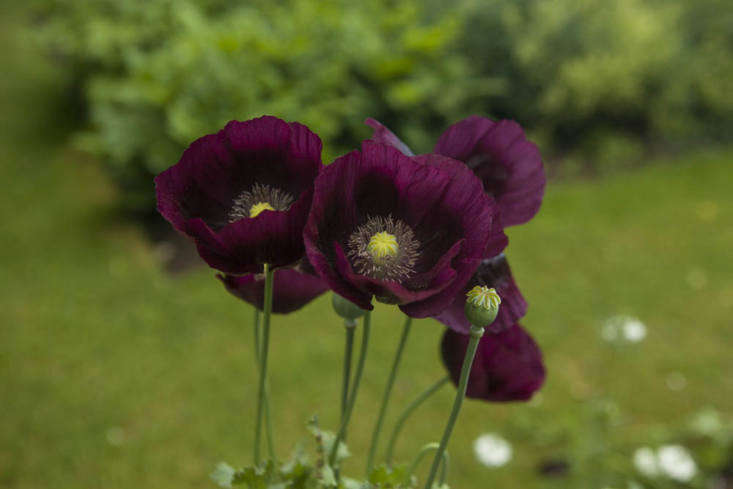Opium Poppy, Papaver somniferum
The notoriety of Papaver somniferum, the “sleep-inducing poppy,” is only partly to do with its outlaw family.
Opium poppies are grown for their edible seeds and for pharmaceutical uses. The type that you see in gardens—whether your own or in the medicinal section of a botanic garden—is the legal relation, not toxic enough to be useful to anyone. The subversive beauty of P. somniferum is firmly rooted in its fabulous color and texture, and the way it can turn a vegetable patch into a Dutch painting.
Photography by Jim Powell for Gardenista.

More correctly but prosaically called “breadseed poppy,” Papaver somniferum is an unknown quantity when in bud. A couple of nearby seeds may result in shades of profound magenta and desirable pink, like the wild opium poppies in our vegetable garden, at the top of this page. On the other hand, they could germinate into the tawdriest hues of clapped-out mauve, in which case you are perfectly within your rights to pull them out.

This is the great thing about self-seeding plants: If you edit them, they look purposeful. If you don’t, then they are weeds, run amok. Opium poppies grow well with other poppies, seen here at the Oxford Botanic Garden, in the medicinal plant beds. But it’s more fun to allow them to pop up wherever they like. In soil that is rich, like a vegetable garden, they will grow stout and tall, with handsome glaucous foliage and green-gray seed heads on strong stalks.

Dutch masters (and Dutch mistresses such as Rachel Ruysch and Maria van Oosterwyck ) demonstrated their talent for photo-realist detail when they painted the backs of flowers, as well as the fronts, in the 17th century. Who can blame them? Every part of an opium poppy is fascinating and useful, from seed to flower to decorative dried seed head. The stalks also have a way of creating bends that eventually reach skyward.

Dutch “vanitas” paintings also featured decaying leaves of opium poppies, which are more fleshy and cabbage-like than those of oriental poppy or common poppy (Papaver rhoeas). After the petals from a series of buds have finally finished dropping (this goes on for longer than you might think), the plant does look rather sorry, as the green drains away. It’s important to leave well alone for more poppies next year, since these are annuals.

There are plenty of named varieties of opium poppy, if you are introducing them into your garden or would like to add color depth, in the knowledge that they will eventually cross-pollinate. In the UK, Special Plants sells a dark, single poppy like the one shown here, called Papaver somniferum ‘Lauren’s Grape’ (£2 for a packet of 20 seeds) that can reach heights of feet.

Renee’s Garden in the US offers an heirloom selection of opium poppy seeds (which are legal, they carefully point out) called ‘Pepperbox Poppy’ ($2.99 for a packet of 1,000 seeds).
Cheat Sheet
- Opium poppies are happy companions to vegetables and herbs in an edible garden.
- Some favorite named varieties include P. somniferum ‘Sissinghurst White’ and frilly ‘Drama Queen’.
- To sow, sprinkle seeds on the surface of prepared soil (but do not cover them).

Keep It Alive
- Opium poppies prefer soil that is preferably moist but definitely well-drained.
- They seem undisturbed by wind and cling on to their petals while being blown about.
- Papaver somniferum thrives in sun or semi-shade.
See more growing tips at Opium Poppy: A Field Guide to Planting, Care & Design in our curated guides to Annuals 101. Read more:
- Poppies in Paradise: A Garden Visit in Healdsburg, California
- Rethinking Poppies: How to Make a Fragile Flower Last Longer
- How to Grow Annual Flowers: A Field Guide to Planting, Care & Design














Have a Question or Comment About This Post?
Join the conversation (0)